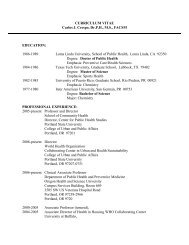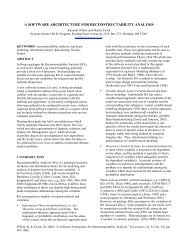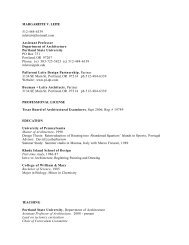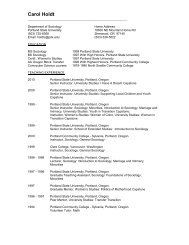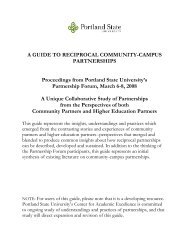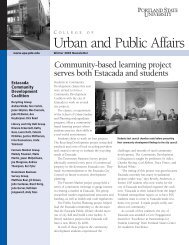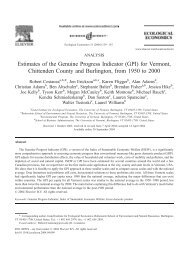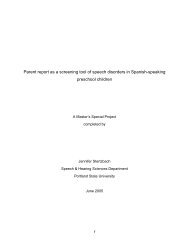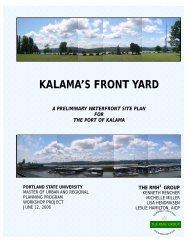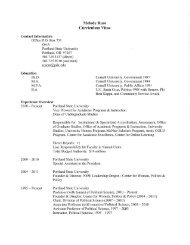Effects of integral stimulation therapy on speech - Portland State ...
Effects of integral stimulation therapy on speech - Portland State ...
Effects of integral stimulation therapy on speech - Portland State ...
You also want an ePaper? Increase the reach of your titles
YUMPU automatically turns print PDFs into web optimized ePapers that Google loves.
welcomed from CP’s parents who were <str<strong>on</strong>g>of</str<strong>on</strong>g>ten the first to notice <strong>speech</strong> skills worked <strong>on</strong><br />
in clinic being used sp<strong>on</strong>taneously at home.<br />
Treatment techniques began by establishing c<strong>on</strong>sistent producti<strong>on</strong> <str<strong>on</strong>g>of</str<strong>on</strong>g> target<br />
sounds in single syllable producti<strong>on</strong>s using first established vowel sounds. As CP’s<br />
c<strong>on</strong>sistency increased during drill practice, the envir<strong>on</strong>ment in which the targets were<br />
presented increased in complexity. Word shape complexity, syllable numbers, phrase<br />
lengths, and c<strong>on</strong>versati<strong>on</strong>al c<strong>on</strong>texts were increased as CP’s pr<str<strong>on</strong>g>of</str<strong>on</strong>g>iciency grew.<br />
A variety <str<strong>on</strong>g>of</str<strong>on</strong>g> visual, auditory, and tactile supports were employed by the clinician<br />
to assist CP in achieving correct producti<strong>on</strong>s <str<strong>on</strong>g>of</str<strong>on</strong>g> target sounds. Clinician models included<br />
visual and auditory producti<strong>on</strong>s <str<strong>on</strong>g>of</str<strong>on</strong>g> target sounds using a mirror and face to face<br />
interacti<strong>on</strong>. CP was instructed to watch the clinician’s mouth and listen carefully. CP was<br />
directed to produce sounds first simultaneously, then imitatively, and later with delayed<br />
imitati<strong>on</strong>, and with a variety <str<strong>on</strong>g>of</str<strong>on</strong>g> visual supports such as foam letters, written words,<br />
mouthed imitati<strong>on</strong>s, and pictorial depicti<strong>on</strong>s <str<strong>on</strong>g>of</str<strong>on</strong>g> oral placements. Tactile gestures were<br />
provided to indicate the locati<strong>on</strong> <str<strong>on</strong>g>of</str<strong>on</strong>g> articulator c<strong>on</strong>tacts. CP was encouraged to feel his<br />
throat during voiced producti<strong>on</strong>s and feel oral air emissi<strong>on</strong>s with his hand during<br />
appropriate sound producti<strong>on</strong>s (stops and fricatives). Signed letters were occasi<strong>on</strong>ally<br />
used to stimulate CP’s awareness <str<strong>on</strong>g>of</str<strong>on</strong>g> upcoming target sounds before producing them.<br />
Supports were faded as the accuracy <str<strong>on</strong>g>of</str<strong>on</strong>g> CP’s producti<strong>on</strong>s increased.<br />
Feedback <str<strong>on</strong>g>of</str<strong>on</strong>g> CP’s <strong>speech</strong> sound performance was <str<strong>on</strong>g>of</str<strong>on</strong>g>fered in the form <str<strong>on</strong>g>of</str<strong>on</strong>g> specific<br />
knowledge <str<strong>on</strong>g>of</str<strong>on</strong>g> results. Both correct and incorrect producti<strong>on</strong>s were given feedback.<br />
Correct producti<strong>on</strong>s would <str<strong>on</strong>g>of</str<strong>on</strong>g>ten be followed by statements such as; “Hey, those top teeth<br />
are touching your bottom lip!” or “I heard a hissing /s/ sound.” Incorrect producti<strong>on</strong>s <str<strong>on</strong>g>of</str<strong>on</strong>g><br />
44



